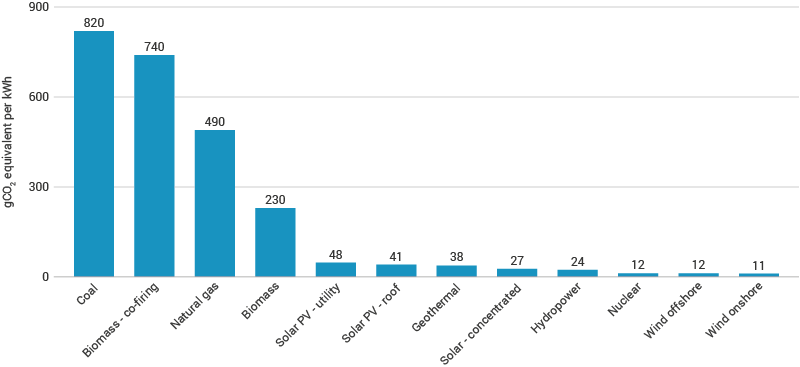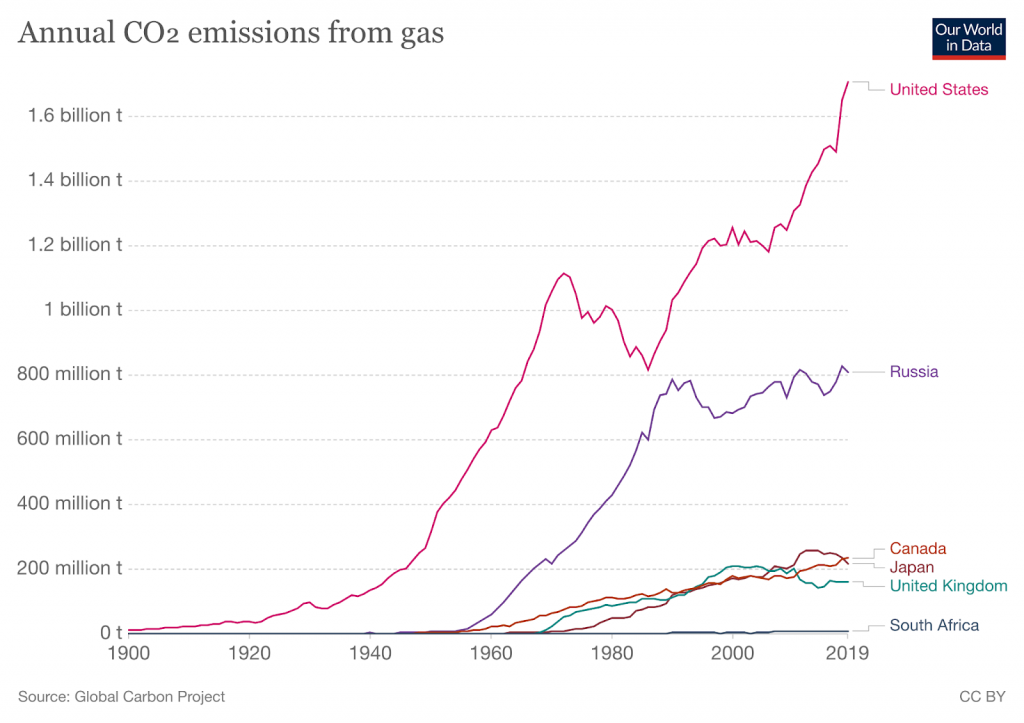What Is the Carbon Footprint of Natural Gas? A Life-Cycle Assessment
Impactful Ninja is reader-supported. When you buy through links on our site, we may earn an affiliate commission.
Learn more
Learn more
.
Hey fellow impactful ninja ? You may have noticed that Impactful Ninja is all about providing helpful information to make a positive impact on the world and society. And that we love to link back to where we found all the information for each of our posts. Most of these links are informational-based for you to check out their primary sources with one click. But some of these links are so-called "affiliate links" to products that we recommend. First and foremost, because we believe that they add value to you. For example, when we wrote a post about the environmental impact of long showers, we came across an EPA recommendation to use WaterSense showerheads. So we linked to where you can find them. Or, for many of our posts, we also link to our favorite books on that topic so that you can get a much more holistic overview than one single blog post could provide. And when there is an affiliate program for these products, we sign up for it. For example, as Amazon Associates, we earn from qualifying purchases. First, and most importantly, we still only recommend products that we believe add value for you. When you buy something through one of our affiliate links, we may earn a small commission - but at no additional costs to you. And when you buy something through a link that is not an affiliate link, we won’t receive any commission but we’ll still be happy to have helped you. When we find products that we believe add value to you and the seller has an affiliate program, we sign up for it. When you buy something through one of our affiliate links, we may earn a small commission (at no extra costs to you). And at this point in time, all money is reinvested in sharing the most helpful content with you. This includes all operating costs for running this site and the content creation itself. You may have noticed by the way Impactful Ninja is operated that money is not the driving factor behind it. It is a passion project of mine and I love to share helpful information with you to make a positive impact on the world and society. However, it's a project in that I invest a lot of time and also quite some money. Eventually, my dream is to one day turn this passion project into my full-time job and provide even more helpful information. But that's still a long time to go. Stay impactful,Affiliate Disclosure
Why do we add these product links?
What do these affiliate links mean for you?
What do these affiliate links mean for us?
What does this mean for me personally?
![]()
Natural gas is often referred to as the cleanest burning fossil fuel, and it is responsible for a large portion of the world’s electricity generation. But it is a fossil fuel nonetheless. So, we had to ask: What is the carbon footprint of natural gas?
Natural has one of the highest carbon footprints of all energy types. Per kWh produced, natural gas emits 490 grams of carbon dioxide (CO2) on a life-cycle basis. Although it produces lower levels of CO2 than the other two fossil fuels, coal and oil, it still directly contributes to climate change.
Natural gas makes around 34% of total US energy consumption and has various environmental implications. Keep reading to learn about the overall carbon footprint of natural gas and its carbon footprint throughout its life-cycle.
How is Natural Gas Defined
Commonly referred to as the world’s cleanest fossil fuel, natural gas (NG) is a flammable gas composed of mostly methane (CH4), some hydrocarbon gas liquids (HGLs), and nonhydrocarbon gases (CO2 and water vapor). When burned it produces mostly CO2, water vapor, and some nitrogen oxides.
“Natural Gas: flammable gas, consisting largely of methane and other hydrocarbons, occurring naturally underground (often in association with petroleum) and used as fuel”
Oxford Dictionary
NG is acquired in one of two ways, either by conventional drilling or by hydraulic fracturing. In the former, vertical or horizontal wells are drilled down into NG reservoirs and the NG flows to the surface through these wells. In the latter, water, chemicals, and sand are forced down through the well at high pressure, breaking the rock formation containing the NG. The NG is released and flows up through the well to the surface.
NG is used primarily for heating and generating electricity but can also be used as a raw material (feedstock) in the production of chemicals, fertilizer, and hydrogen, and as lease and plant fuel. In 2020, 30.5 trillion cubic feet (Tcf) of NG were consumed in the US alone. This represents around 34% of total US energy consumption.
What is the Carbon Footprint of Natural Gas
The carbon footprint is one of the ways we measure the effects of human-induced global climate change. It primarily focuses on the greenhouse gas (GHG) emissions associated with consumption, but also includes other emissions such as CH4, nitrous oxide, and chlorofluorocarbons.
“Carbon footprint: the amount of greenhouse gases and specifically carbon dioxide emitted by something (such as a person’s activities or a product’s manufacture and transport) during a given period”
Merriam Webster
Basically, it is the amount of carbon emitted by an activity or an organization. This includes GHG emissions from fuel that we burn directly (e.g., heating a home, driving a car) and GHG emissions from manufacturing the products that we use (e.g., power plants, factories, and landfills).
What Is the Overall Carbon Footprint of Natural Gas
NG emits 490 grams of CO2 equivalent per kWh, the third-highest amount out of all of the fuel types, but the lowest out of the three fossil fuels.

The world collectively emitted 7.62 billion tons (bt) from NG in 2019, the fewest amount out of the three fossil fuels.

Since 2010, 80% of NG growth has been concentrated within the US, China, and the Middle East.

The six largest NG producing countries (amount per year) in the world are:
- United States – 921 billion cubic meters (bcm)
- Russia – 679 bcm
- Iran – 244 bcm
- Qatar – 178 bcm
- China – 178 bcm
- Canada – 173 bcm
Because NG is the world’s fastest-growing fossil fuel that accounts for around 23% of primary energy demand and 25% of electricity generation, it is important to understand what its carbon footprint is and how its carbon emissions affect the global climate change process.
To understand the carbon footprint of natural gas, we must assess its life-cycle and each stage’s carbon footprint. This life-cycle assessment (LCA) is a method to evaluate the environmental impacts of products and materials. Over the years, companies have strategically used LCA to research and create more sustainable products. So, let’s have a look at the LCA of natural gas!
| The life-cycle stages of natural gas | Each stage’s carbon footprint |
| Building of natural gas | CO2 emissions from extracting and processing NG, transportation of NG through pipes and on ships, construction of NG power plants |
| Operating of natural gas | CO2 emissions from NG combustion, operation of equipment at NG power plants, and leakage of CH4 from in-service wells |
| Building back of natural gas | CO2 emissions from plugging wells and decommissioning power plants CH4 seepage from unplugged wells |
The total carbon footprint of NG would equal the carbon footprint from building + the carbon footprint from operating + the carbon footprint from building back.
What Is the Carbon Footprint of Building Natural Gas
Building NG includes extracting and processing the gas, constructing the power plant, and transporting the material from the well site to the power plant.
NG is extracted via drilling or fracking to expose NG reservoirs. Horizontal drilling, hydraulic fracturing, and acidizing are methods utilized to maximize the amount of NG extracted.
Extracting NG involves seven main steps:
- Preparing the rig site
- Drilling
- Cementing and testing
- Well completion
- Fracking
- Production and fracking fluid recycling
- Well abandonment and land restoration
NG and oil are extracted from the same well. NG is dissolved in oil, so pure NG contains contaminants that need to be removed before NG can be transported through pipelines. Processing NG is often complex and consists of many steps to remove impurities such as oil, water, HGLs, sulfur, helium, nitrogen, hydrogen sulfide, and CO2. Each well site is different, and the steps required vary from well to well.
Processing NG typically involves four main steps:
- Oil and Condensate Removal
- Water Removal
- Separation of Natural Gas Liquids
- Sulfur and Carbon Dioxide Removal
Once the NG has been extracted and processed it is transported from well sites to power plants by pipeline or by ship. Constructing the pipelines and burning diesel fuel for transportation have carbon footprints. Burning one gallon of diesel fuel produces 22.38 pounds of CO2.
NG power plants also have many components, and constructing these components requires machinery that emits CO2. Boiler rooms, smokestacks, generators, and turbines are all components with a carbon footprint.
What Is the Carbon Footprint of Operating Natural Gas
Emissions at this stage occur upon extraction, processing, and combustion of NG, are associated with the operation of the mechanical equipment (e.g. turbines and generators) at the power plant, and are released when oil and NG wells, storage tanks, pipelines, or processing plants leak methane into the atmosphere.
Burning NG emits 117 lbs of CO2 per million Btu. Although the CO2 emissions from the combustion of NG are about 50%-60% less than those from coal and oil, the primary component of NG, CH4, is 34 times stronger at trapping heat than CO2 over 100 years. This means that a little CH4 can go a long way when contributing to global warming.
What Is the Carbon Footprint of Building Back Natural Gas
NG plants have an average age of 22 years in the US. When a well is done producing NG it is plugged to stop the flow of methane to the surface. However, over 3 million abandoned oil and gas wells are unplugged in the US alone, and these wells leak millions of metric tons of methane into our atmosphere every year. Simply plugging these wells could reduce methane emissions by 99%, which would help mitigate global warming.
CO2 emissions at this stage occur when abandoned wells are not plugged and when utilizing construction equipment to demolish buildings and construct new buildings in the old power plant’s place.
What Role Does Natural Gas Play in Contributing to Climate Change
Climate change is arguably the most severe, long-term, global impact of fossil fuel combustion. Every year, approximately 36 bt of CO2 are emitted from burning fossil fuels. 7.5 bt (21%) of this comes from NG. The carbon found in fossil fuels reacts with oxygen in the air to produce CO2. This warms the earth by acting as a heating blanket, and a warmer earth comes with a host of negative side effects. Also with natural gas, CH4 leaks release GHG emissions that are substantially more potent than CO2.
CO2 and CH4 emissions contribute to climate change in the following ways:
- Increasing temperatures: Earth’s atmosphere has warmed 1.5℃ since 1880. This may not seem like a lot, but these degrees create regional and seasonal temperature extremes, reduce sea ice, intensify rainfall and drought severity, and change habitat ranges for plants and animals.
- Rising sea levels: Global sea levels have increased approximately 8-9 inches since 1880, displacing people living along coastlines and destroying coastal habitats. Roads, bridges, subways, water supplies, oil and gas wells, power plants, sewage treatment plants, and landfills remain at risk if sea level rise goes unchecked.
- Melting of sea ice: Since 1979 arctic sea ice has declined by 30%. Sea ice plays a major role in regulating the earth’s climate by reflecting sunlight into space and providing habitat for animal species. If all of the glaciers on Earth melted, sea levels would rise by approximately 70 feet, effectively flooding out every coastal city on the planet.
- Changing precipitation patterns: Extreme weather events (e.g., hurricanes, floods, droughts) are becoming more common and more intense. Storm-affected areas will experience increased precipitation and flooding whereas areas located further from storm tracks will experience decreased precipitation and droughts.
- Ocean acidification: The ocean absorbs 30% of the CO2 released into the atmosphere, which decreases the pH (increases the acidity) of the ocean. In the past 200 years, the pH of oceans has decreased by 0.1 pH units, which translates to a 30% increase in acidity. Aquatic life unable to adjust to this rapid acidification will die off. A prime example of this is coral bleaching, where coral expel the algae (zooxanthellae) living in their tissues as a result of changes in temperature, light, or nutrients.
The more we reduce CO2 emissions, the more we slow the rate of temperature rise, sea-level rise, ice melting, and ocean acidification. When these rates are slowed, the earth’s biodiversity does not have to struggle to adapt to temperature and pH changes. People will not be displaced due to the flooding of coastal areas. And icebergs will continue to provide climate regulation.
How Environmentally Friendly Is Natural Gas
NG is one of the world’s most abundant fossil fuel sources, but the combustion of NG produces over 7 bt of CO2 emissions every year, contributing significantly to global climate change.
“Environmentally friendly: (of products) not harming the environment.”
Cambridge Dictionary
NG is often touted as the cleanest fossil fuel because its rate of CO2 emissions that contribute to global climate change is lower than that of coal and oil. However, NG still possesses environmental drawbacks that must be taken into consideration, along with the benefits.
What Are Environmental Benefits of Natural Gas
Although NG is a fossil fuel, there are ways to reduce its environmental impact. And as a plus, its CO2 emissions are lower than that of coal and oil.
- Controlling CH4 Leaks: NG is considered the cleanest fossil fuel because it has lower levels of CO2, CO, nitrogen oxides, and SO2 than both coal and oil. However, these emissions and CH4 still contribute directly to global climate change. The best way to mitigate its environmental impact is to detect, fix, and repair CH4 leaks from well-pads, processing plants, compressor stations, and large distribution facilities. Doing this can reduce CH4 output by 1.70-1.80 million metric tons per year. Plugging abandoned NG wells also prevents the seepage of methane into the atmosphere.
- Prioritize Renewable Natural Gas (RNG): RNG is biogas, the product of organic matter decomposition, that has been processed and purified. It can then be used as a transportation fuel in the form of compressed natural gas (CNG) or liquefied natural gas (LNG). Because there is no drilling or fracking, RNG has a lower carbon footprint than NG.
- Recycle Water and Use Efficient Production Practices: Fracking uses a large amount of water, so recycling water and avoiding utilizing freshwater sources can reduce water requirements. Constructing wells properly and maintaining them after drilling is complete is crucial for efficiency.
- Implement Practices that Reduce Risk of Induced Seismicity: Fracking can cause seismic activity that leads to earthquakes. Avoiding water injection into active fault lines, limiting injection rates, installing seismic monitors, establishing a protocol for when seismic activity is induced, and abandoning wells with seismic activity are all ways to mitigate this threat.
NG can be more efficient and environmentally friendly if certain protocols and environmental mitigation practices are followed.
What Are Environmental Drawbacks of Natural Gas
NG is a cleaner-burning fossil fuel than both coal and oil, but it still has environmental drawbacks that are important to understand.
- Drilling: This can disturb vegetation and soil and may require clearing and leveling the area around a well pad. Drilling also produces air pollution and may contaminate water sources via erosion, fracking fluids, equipment runoff, and sedimentation.
- Landscape Alterations: Drilling for NG causes surface distribution from drill pads, roads, and pipelines that alter the landscape. Fragmentation of wildlife habitat and migration patterns have also been documented.
- Water Pollution: Land clearing may cause dirt, minerals, and other pollutants to erode into nearby waterways. Drinking water may become contaminated with hazardous chemicals via drilling, fracturing, processing, and refining the gas, and wastewater disposal.
- Air Pollution: When NG is burned at well sites, it releases CO2, carbon monoxide (CO), sulfur dioxide (SO2), and nitrogen oxides into the atmosphere. Burning NG instead of releasing it directly into the atmosphere produces lower levels of GHG emissions because CO2 is not as potent as CH4, but it still contributes to the overall level of CO2 in our atmosphere.
- Atmospheric CO2: Levels of CO2 in our atmosphere have increased as a result of human emissions since the beginning of the Industrial Revolution in 1750. Emissions increased steadily to 5 billion tons per year in the mid-20th century before increasing exponentially to more than 35 billion tons per year at the end of the 20th century. The global average amount of carbon dioxide in the atmosphere was about 280 parts per million (ppm) in 1750 but today registers at over 400 ppm. By the end of the 21st century, this number is expected to exceed 900 ppm. Burning coal adds to this total, which in turn amplifies the greenhouse effect and causes global warming.
- Global Warming: This phenomenon occurs when CO2 and other air pollutants absorb sunlight and solar radiation in the atmosphere, trapping the heat and acting as an insulator for the planet. Since the Industrial Revolution, Earth’s temperature has risen a little more than 1 degree Celsius (C), or 2 degrees Fahrenheit (F). Between 1880-1980 the global temperature rose by 0.07C every 10 years. This rate has more than doubled since 1981, with a current global annual temperature rise of 0.18C, or 0.32F, for every 10 years. Experts claim that to avoid a future plagued by rising sea levels, acidified oceans, loss of biodiversity, more frequent and severe weather events, and other environmental disasters brought on by the hotter temperatures, we must limit global warming to 1.5C by 2040.
NG drilling can alter the landscape and contaminate water sources. NG combustion also adds to atmospheric CO2 levels and contributes to global warming. The easiest way to mitigate the environmental impact of NG is to simply not rely on it in the first place. NG combustion releases toxic chemicals and heavy metals, leaks CH4, and contributes directly to global warming.
Final Thoughts
NG is commonly referred to as the cleanest burning fossil fuel, ahead of both coal and oil, because it releases less CO2 than the two when burned. However, it is composed mostly of methane, which has a much higher global warming potential than CO2. This is why controlling and reducing the frequency of methane leaks is crucial when discussing NGs’ carbon footprint.
NG is still a fossil fuel, so it comes with negative environmental effects including landscape alterations, air and water pollution, and CO2 generation. These could be mitigated if NG were not used. Time is running out to reverse the effects of climate change caused by human CO2 emissions and although NG is cleaner than other fossil fuels we should not consider it as our solution to climate change.
Stay impactful,

Sources
- US Energy Information Administration: Natural Gas Explained
- US Energy Information Administration: Use of Natural Gas
- Britannica: Carbon Footprint
- United States Environmental Protection Agency: System of Registries
- American Gas Association: What is Natural Gas?
- World Nuclear Association: Carbon Emissions from Electricity
- Our World in Data: CO2 emissions by fuel
- NS Energy: Profiling the top six natural gas producing countries in the world
- International Energy Agency: Gas
- McKinsey Sustainability: Climate risk and decarbonization – What every mining CEO needs to know
- Science Direct: Life-cycle assessment (LCA)
- MIT SMR: Strategic Sustainability Uses of Life-Cycle Analysis
- National Geographic: Natural Gas
- Coloradans for Responsible Energy Development: The seven steps of oil and natural gas extraction
- NaturalGas.org: Processing natural gas
- Natural Resources Canada: Learn the facts – fuel consumption and CO2
- US Energy Information Administration: How much carbon dioxide is produced when different fuels are burned?
- Union of Concerned Scientists: Environmental Impacts of Natural Gas
- US Energy Information Administration: Natural gas generators make up the largest share of overall U.S. generation capacity
- Forbes: Plugging Abandoned Oil Wells Is One ‘Green New Deal’ Aspect Loved By Both Republicans And Democrats
- The National Wildlife Federation: Climate Change
- National Oceanic and Atmospheric Administration: Climate Change – Global Temperature
- National Oceanic and Atmospheric Administration: Climate Change – Global Sea Level
- United States Geological Survey: How would sea level change if all glaciers melted?
- National Aeronautics and Space Administration, U.S.A.: How does climate change affect precipitation?
- National Oceanic and Atmospheric Administration: Ocean Acidification
- National Ocean Service: What is coral bleaching?
- Business for Social Responsibility: Fuel Sustainability Brief – Natural Gas
- US Department of Energy: Alternative Fuels Data Center – Renewable Natural Gas Production
- Natural Resources Defense Council: Reducing Natural Gas Leakage to Protect the Environment Is Easy to Do, Saves Money, and Creates Jobs
- United States Geological Survey: Landscape Effects of Oil and Gas Development
- US Energy Information Administration: Natural gas and the environment
- National Oceanic and Atmospheric Administration: Climate Change – Atmospheric Carbon Dioxide
- National Resources Defense Council: Global Warming 101




